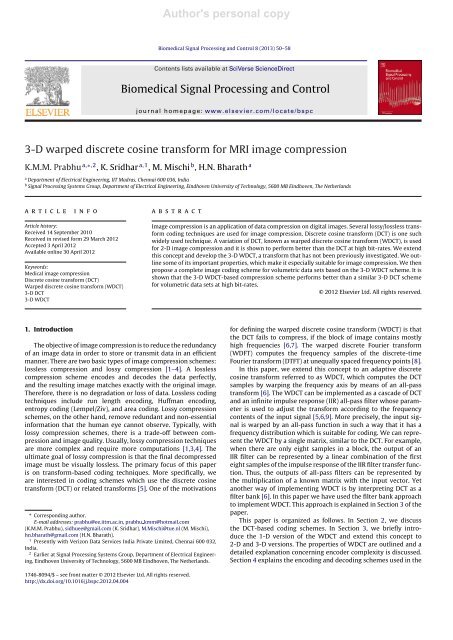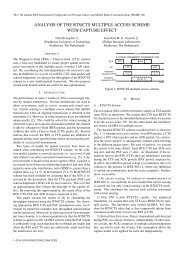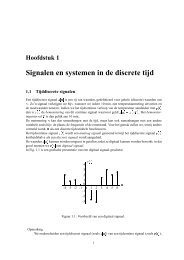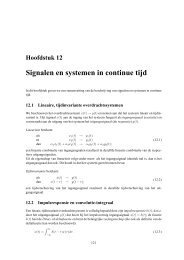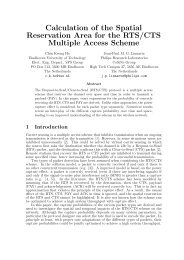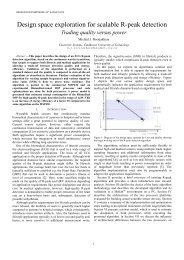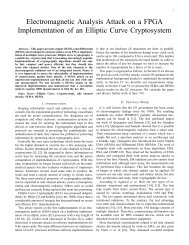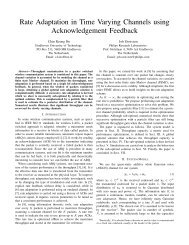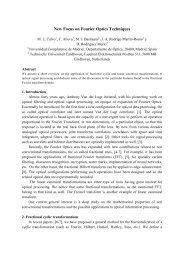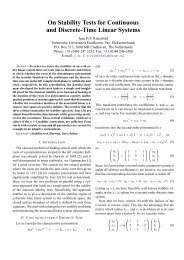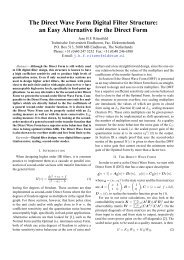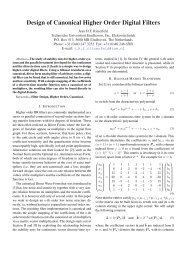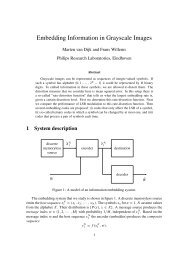K.M.M. Prabhu, K. Sridhar, M. Mischi, H.N. Bharath, R.K. Reddy
K.M.M. Prabhu, K. Sridhar, M. Mischi, H.N. Bharath, R.K. Reddy
K.M.M. Prabhu, K. Sridhar, M. Mischi, H.N. Bharath, R.K. Reddy
You also want an ePaper? Increase the reach of your titles
YUMPU automatically turns print PDFs into web optimized ePapers that Google loves.
Author's personal copy<br />
Biomedical Signal Processing and Control 8 (2013) 50–58<br />
Contents lists available at SciVerse ScienceDirect<br />
Biomedical Signal Processing and Control<br />
j o ur nal homep a ge: www.elsevier.com/locate/bspc<br />
3-D warped discrete cosine transform for MRI image compression<br />
K.M.M. <strong>Prabhu</strong> a,∗,2 ,K. <strong>Sridhar</strong> a,1 ,M. <strong>Mischi</strong> b , H.N. <strong>Bharath</strong> a<br />
a Department of Electrical Engineering, IIT Madras, Chennai 600 036, India<br />
b Signal Processing Systems Group, Department of Electrical Engineering, Eindhoven University of Technology, 5600 MB Eindhoven, The Netherlands<br />
a r t i c l e i n f o<br />
Article history:<br />
Received 14 September 2010<br />
Received in revised form 29 March 2012<br />
Accepted 3 April 2012<br />
Available online 30 April 2012<br />
Keywords:<br />
Medical image compression<br />
Discrete cosine transform (DCT)<br />
Warped discrete cosine transform (WDCT)<br />
3-D DCT<br />
3-D WDCT<br />
a b s t r a c t<br />
Image compression is an application of data compression on digital images. Several lossy/lossless transform<br />
coding techniques are used for image compression. Discrete cosine transform (DCT) is one such<br />
widely used technique. A variation of DCT, known as warped discrete cosine transform (WDCT), is used<br />
for 2-D image compression and it is shown to perform better than the DCT at high bit-rates. We extend<br />
this concept and develop the 3-D WDCT, a transform that has not been previously investigated. We outline<br />
some of its important properties, which make it especially suitable for image compression. We then<br />
propose a complete image coding scheme for volumetric data sets based on the 3-D WDCT scheme. It is<br />
shown that the 3-D WDCT-based compression scheme performs better than a similar 3-D DCT scheme<br />
for volumetric data sets at high bit-rates.<br />
© 2012 Elsevier Ltd. All rights reserved.<br />
1. Introduction<br />
The objective of image compression is to reduce the redundancy<br />
of an image data in order to store or transmit data in an efficient<br />
manner. There are two basic types of image compression schemes:<br />
lossless compression and lossy compression [1–4]. A lossless<br />
compression scheme encodes and decodes the data perfectly,<br />
and the resulting image matches exactly with the original image.<br />
Therefore, there is no degradation or loss of data. Lossless coding<br />
techniques include run length encoding, Huffman encoding,<br />
entropy coding (Lempel/Ziv), and area coding. Lossy compression<br />
schemes, on the other hand, remove redundant and non-essential<br />
information that the human eye cannot observe. Typically, with<br />
lossy compression schemes, there is a trade-off between compression<br />
and image quality. Usually, lossy compression techniques<br />
are more complex and require more computations [1,3,4]. The<br />
ultimate goal of lossy compression is that the final decompressed<br />
image must be visually lossless. The primary focus of this paper<br />
is on transform-based coding techniques. More specifically, we<br />
are interested in coding schemes which use the discrete cosine<br />
transform (DCT) or related transforms [5]. One of the motivations<br />
∗ Corresponding author.<br />
E-mail addresses: prabhu@ee.iitm.ac.in, prabhu kmm@hotmail.com<br />
(K.M.M. <strong>Prabhu</strong>), sidhuee@gmail.com (K. <strong>Sridhar</strong>), M.<strong>Mischi</strong>@tue.nl (M. <strong>Mischi</strong>),<br />
hn.bharath@gmail.com (H.N. <strong>Bharath</strong>).<br />
1 Presently with Verizon Data Services India Private Limited, Chennai 600 032,<br />
India.<br />
2 Earlier at Signal Processing Systems Group, Department of Electrical Engineering,<br />
Eindhoven University of Technology, 5600 MB Eindhoven, The Netherlands.<br />
for defining the warped discrete cosine transform (WDCT) is that<br />
the DCT fails to compress, if the block of image contains mostly<br />
high frequencies [6,7]. The warped discrete Fourier transform<br />
(WDFT) computes the frequency samples of the discrete-time<br />
Fourier transform (DTFT) at unequally spaced frequency points [8].<br />
In this paper, we extend this concept to an adaptive discrete<br />
cosine transform referred to as WDCT, which computes the DCT<br />
samples by warping the frequency axis by means of an all-pass<br />
transform [6]. The WDCT can be implemented as a cascade of DCT<br />
and an infinite impulse response (IIR) all-pass filter whose parameter<br />
is used to adjust the transform according to the frequency<br />
contents of the input signal [5,6,9]. More precisely, the input signal<br />
is warped by an all-pass function in such a way that it has a<br />
frequency distribution which is suitable for coding. We can represent<br />
the WDCT by a single matrix, similar to the DCT. For example,<br />
when there are only eight samples in a block, the output of an<br />
IIR filter can be represented by a linear combination of the first<br />
eight samples of the impulse response of the IIR filter transfer function.<br />
Thus, the outputs of all-pass filters can be represented by<br />
the multiplication of a known matrix with the input vector. Yet<br />
another way of implementing WDCT is by interpreting DCT as a<br />
filter bank [6]. In this paper we have used the filter bank approach<br />
to implement WDCT. This approach is explained in Section 3 of the<br />
paper.<br />
This paper is organized as follows. In Section 2, we discuss<br />
the DCT-based coding schemes. In Section 3, we briefly introduce<br />
the 1-D version of the WDCT and extend this concept to<br />
2-D and 3-D versions. The properties of WDCT are outlined and a<br />
detailed explanation concerning encoder complexity is discussed.<br />
Section 4 explains the encoding and decoding schemes used in the<br />
1746-8094/$ – see front matter © 2012 Elsevier Ltd. All rights reserved.<br />
http://dx.doi.org/10.1016/j.bspc.2012.04.004


